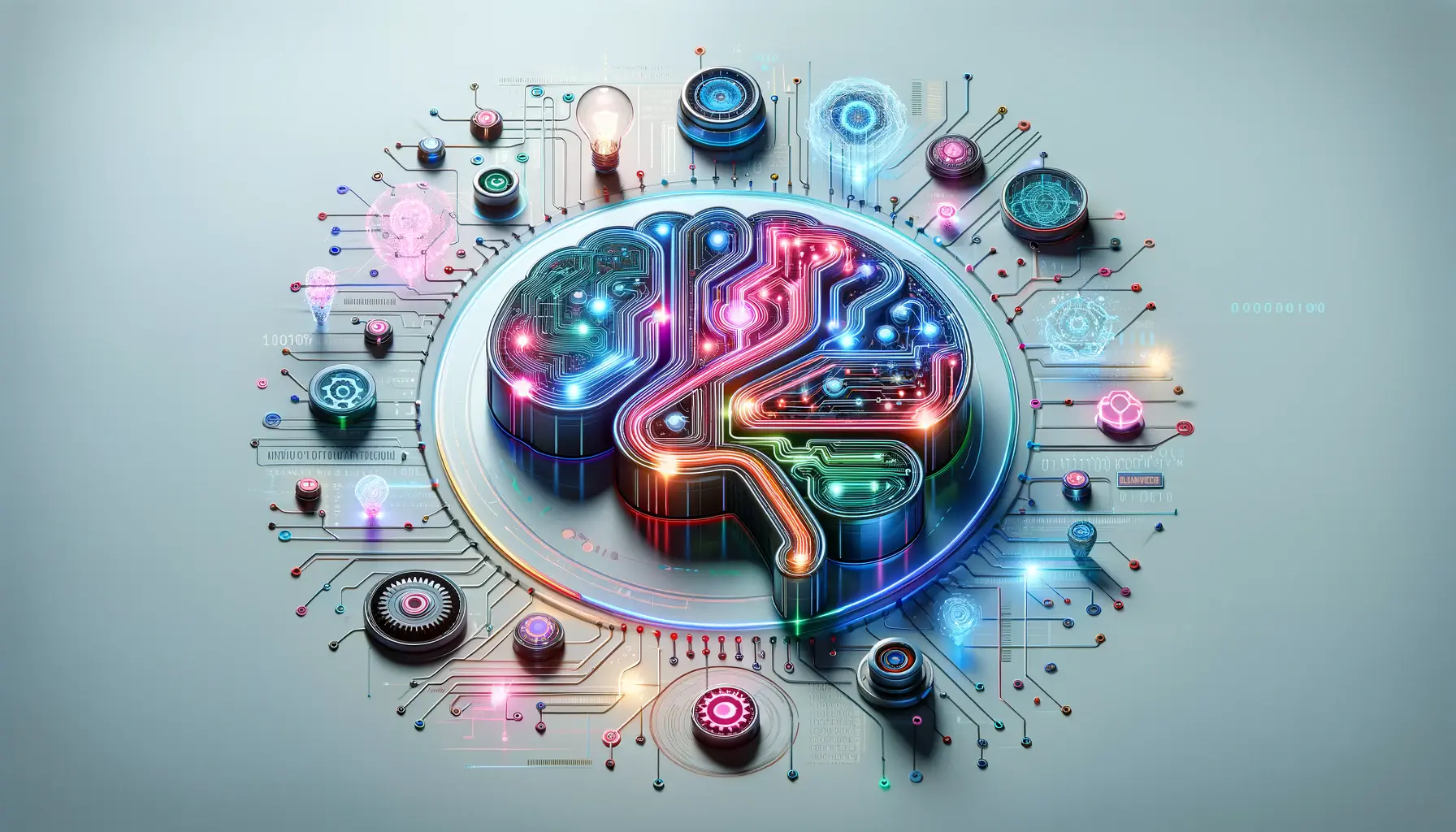In the rapidly evolving landscape of technology and innovation, Google has once again positioned itself at the forefront with the introduction of Bard, its latest generative AI tool.
This development marks a significant leap forward, not just for Google, but for the broader field of product development and innovation.
Bard, initially known as a conversational AI, has transcended its initial purpose to become a pivotal tool in the creative and developmental processes of products and services across various industries.
At its core, Bard is designed to harness the vast capabilities of artificial intelligence to generate new ideas, solve complex problems, and offer insights that were previously unattainable.
Its integration into product development processes signifies a new era where AI and human creativity merge to push the boundaries of what’s possible, making innovation more accessible, efficient, and impactful.
- The Genesis of Bard and Its Evolution
- Enhancing Creativity and Problem-Solving
- Optimizing Market Research and Analysis
- Accelerating Product Design and Development
- Improving User Experience and Satisfaction
- Facilitating Continuous Improvement and Innovation
- Empowering Cross-Functional Teams
- Harnessing the Power of Bard for Future-Forward Product Development
- Google Bard FAQ: Navigating the Future of AI in Product Development
The Genesis of Bard and Its Evolution
The inception of Bard by Google was a response to the growing demand for more sophisticated AI tools that could do more than just perform tasks—they needed to think, learn, and assist in creative processes.
Drawing from the vast reservoir of knowledge and data available to Google, Bard was developed to not only understand and interpret human language but to provide contextually relevant, innovative solutions and ideas.
This evolution from a simple chatbot to a comprehensive tool for innovation underscores the rapid advancements in AI technology and its potential to revolutionize industries.
Bard’s development was marked by significant milestones, including its ability to process and analyze large datasets, understand complex queries, and generate coherent, contextually relevant responses.
These capabilities have made it an invaluable asset for teams working on product development, offering a new perspective and enhancing the creative process with data-driven insights and solutions.
Integrating Bard into Product Development
The integration of Bard into the product development process has opened up new avenues for innovation.
By leveraging Bard’s AI capabilities, development teams can quickly ideate, prototype, and test new concepts, significantly reducing the time and resources traditionally required.
Bard’s ability to analyze market trends, consumer behavior, and even predict future demands makes it an essential tool for ensuring that new products are not only innovative but also aligned with market needs and expectations.
Furthermore, Bard’s role in facilitating cross-functional collaboration has been a game-changer.
By providing a common platform for communication and idea generation, Bard helps bridge the gap between different departments, ensuring that all aspects of product development, from design to marketing, are cohesive and aligned with the overall vision and strategy of the project.
The potential of Bard in transforming product development lies not just in its technological capabilities but in its ability to foster a culture of innovation and collaboration.
Enhancing Creativity and Problem-Solving
The advent of Bard has significantly impacted the way creativity and problem-solving are approached within product development.
By providing instant access to a wealth of information and generating creative solutions, Bard has become a catalyst for innovation, enabling teams to explore new ideas and overcome challenges more efficiently.
One of Bard’s standout features is its ability to generate diverse ideas and perspectives.
This not only enriches the brainstorming process but also ensures that no potential avenue for innovation is overlooked.
The tool’s capacity to draw from a vast array of sources and data means that it can offer suggestions that might not have been considered, pushing the boundaries of traditional product development.
Streamlining the Ideation Process
The ideation phase of product development is crucial, yet it can often be hampered by cognitive biases or a lack of fresh ideas.
Bard’s intervention here is transformative, offering:
- Unbiased insights based on data rather than intuition or past experiences, ensuring a wider range of ideas are considered.
- Speedy generation of concepts and solutions, allowing teams to iterate quickly and refine their ideas with unprecedented efficiency.
Moreover, Bard’s ability to understand and interpret complex requirements means that it can provide tailored suggestions that are highly relevant to the specific challenges or goals of a project.
Facilitating Effective Problem-Solving
When it comes to overcoming obstacles in product development, Bard’s role cannot be overstated.
It aids in:
- Identifying the root causes of issues by analyzing data and patterns that might not be immediately apparent to human observers.
- Proposing innovative solutions by leveraging its extensive knowledge base and generative capabilities to think outside the box.
This not only accelerates the problem-solving process but also ensures that solutions are both creative and practical, increasing the likelihood of success for new products.
Bard’s impact on creativity and problem-solving in product development is profound, offering a blend of speed, innovation, and practicality that is reshaping the industry.
Optimizing Market Research and Analysis
Understanding market needs and trends is pivotal in the success of any product.
Bard’s integration into market research and analysis processes has revolutionized how companies gather, interpret, and act on market intelligence.
With its advanced AI capabilities, Bard sifts through vast amounts of data to provide concise, actionable insights that can significantly influence product strategy and development.
By automating the data analysis process, Bard not only saves time but also uncovers patterns and trends that might go unnoticed by human analysts.
This level of insight is invaluable for developing products that not only meet current market demands but also anticipate future trends.
Identifying Consumer Needs and Trends
At the heart of successful product development is a deep understanding of consumer needs and preferences.
Bard plays a crucial role in:
- Aggregating consumer feedback from various sources to provide a comprehensive view of consumer sentiment.
- Analyzing social media, forums, and review sites to identify emerging trends and preferences.
This information allows companies to tailor their products more closely to consumer desires, enhancing the potential for success in competitive markets.
Competitive Analysis and Strategic Planning
Staying ahead in today’s fast-paced market environment requires a keen understanding of the competitive landscape.
Bard aids in:
- Conducting in-depth analysis of competitors’ products, strategies, and market performance.
- Identifying gaps in the market that present opportunities for innovation and differentiation.
These insights are critical for strategic planning, enabling companies to position their products effectively and capitalize on market opportunities.
Leveraging Bard for market research and analysis offers a competitive edge, providing deep insights into consumer behavior and market dynamics that drive informed decision-making.
Accelerating Product Design and Development
The design and development phase is where ideas begin to take physical or digital form.
Bard’s involvement in this phase has been transformative, significantly accelerating the process while ensuring that the end products are both innovative and aligned with user needs.
By offering real-time feedback and suggestions, Bard has become an indispensable tool for design and development teams worldwide.
Its ability to process and analyze feedback from multiple iterations simultaneously means that Bard can suggest design adjustments and improvements that significantly enhance product usability and appeal.
This iterative process, powered by AI, ensures that products are refined to meet the highest standards of quality and functionality.
Enhancing Collaboration Across Teams
Product development is a collaborative effort, involving input from designers, engineers, marketers, and more.
Bard facilitates:
- Seamless communication and idea sharing across different teams, breaking down silos that can hinder product development.
- Generation of comprehensive reports that synthesize feedback from various stakeholders, ensuring that all voices are heard and considered in the development process.
This collaborative environment, enhanced by Bard’s capabilities, fosters innovation and ensures that products are developed with a holistic view of user needs and market demands.
Streamlining Prototyping and Testing
Prototyping and testing are critical for validating design concepts and ensuring that products perform as intended.
Bard’s impact here includes:
- Automating the generation of prototype models based on design specifications, reducing the time and resources required for this phase.
- Analyzing test results to quickly identify areas for improvement, enabling rapid iteration and refinement of prototypes.
This accelerated prototyping and testing cycle not only shortens the time to market but also ensures that the final products are of the highest quality and ready to meet user expectations.
The integration of Bard into product design and development processes marks a significant leap forward, enabling faster, more efficient, and collaborative product creation.
Improving User Experience and Satisfaction
The ultimate goal of any product development effort is to deliver solutions that meet or exceed user expectations, ensuring high levels of user satisfaction.
Bard’s advanced AI capabilities play a crucial role in achieving this goal by enabling a deeper understanding of user needs and facilitating the creation of more personalized, intuitive products.
Through its analysis of user feedback, behavior patterns, and preferences, Bard provides actionable insights that can significantly enhance the user experience (UX).
This not only helps in tailoring products to meet specific user needs but also in identifying opportunities for innovation that can set a product apart in competitive markets.
Personalization at Scale
One of Bard’s most significant contributions to product development is its ability to enable personalization at scale.
By analyzing vast datasets, Bard can identify nuanced user segments and preferences, allowing for:
- The development of customized features and functionalities that cater to specific user needs.
- Dynamic adaptation of products in real-time to match changing user behaviors and expectations.
This level of personalization enhances user engagement and satisfaction, driving loyalty and long-term success for products.
Optimizing User Interfaces for Enhanced Interactions
User interfaces (UI) are the touchpoints through which users interact with products.
Bard’s insights into user preferences and behaviors are invaluable for:
- Designing intuitive and user-friendly interfaces that enhance the overall user experience.
- Identifying UI elements that may cause friction or confusion, allowing for targeted improvements that streamline user interactions.
By optimizing UIs based on Bard’s insights, companies can significantly improve the usability and appeal of their products, leading to higher user satisfaction and engagement.
Leveraging Bard to improve user experience and satisfaction ensures that products not only meet the functional needs of users but also deliver delightful and engaging experiences.
Facilitating Continuous Improvement and Innovation
In today’s dynamic market environment, the ability to continuously improve and innovate is crucial for maintaining competitiveness.
Bard’s AI-driven insights and capabilities provide a solid foundation for ongoing product evolution, ensuring that products remain relevant and continue to meet the changing needs and preferences of users.
By analyzing user feedback, market trends, and technological advancements, Bard identifies opportunities for product enhancements and innovation.
This proactive approach to product development enables companies to stay ahead of the curve, adapting to shifts in the market and user expectations with agility and precision.
Driving Product Evolution with Data-Driven Insights
The key to successful product evolution lies in understanding how users interact with products and what improvements can make their experience better.
Bard excels in:
- Gathering and analyzing user feedback across multiple channels to pinpoint areas for improvement.
- Identifying emerging trends and technologies that can be leveraged to enhance product features and capabilities.
These data-driven insights inform the continuous improvement process, ensuring that products evolve in ways that add value for users.
Enabling Agile Response to Market Changes
The pace of change in today’s marketplaces requires companies to be highly responsive to remain competitive.
Bard supports this need by:
- Providing real-time analysis of market dynamics, enabling companies to quickly adjust their product strategies in response to new developments.
- Offering predictive insights that help anticipate future market trends and user needs, allowing companies to proactively innovate and adapt their products.
This agility is critical for sustaining growth and competitiveness in fast-moving industries, ensuring that products continue to meet and exceed user expectations over time.
Ignoring the potential of Bard in driving continuous improvement and innovation could result in missed opportunities for product enhancement and market leadership.
Empowering Cross-Functional Teams
The development of successful products often requires the collaboration of cross-functional teams, each bringing a unique set of skills and perspectives to the table.
Bard’s ability to provide comprehensive, data-driven insights empowers these teams to work together more effectively, aligning their efforts towards common goals and ensuring that every aspect of the product is optimized for success.
From design and engineering to marketing and customer service, Bard serves as a unifying tool that facilitates communication and collaboration across different departments.
By providing a shared source of intelligence and insights, Bard helps break down silos and fosters a culture of innovation and teamwork.
Enhancing Communication and Alignment
Effective communication and alignment are critical for the success of any product development project.
Bard contributes to:
- Creating a shared understanding of project goals, user needs, and market opportunities among team members.
- Facilitating the exchange of ideas and feedback, ensuring that all voices are heard and considered in the decision-making process.
This enhanced communication and alignment help ensure that projects stay on track and that the final product reflects the collective expertise and vision of the entire team.
Supporting Decision-Making with Data
In the complex and often uncertain process of product development, making informed decisions is paramount.
Bard supports decision-making by:
- Providing access to relevant, up-to-date data and insights that can inform strategy and design choices.
- Offering predictive analytics to assess the potential impact of different decisions, helping teams choose the best course of action.
With Bard’s support, teams can make decisions that are not only based on solid data but also aligned with the overall product strategy and market needs.
The empowerment of cross-functional teams through Bard’s AI-driven insights and capabilities is a testament to the transformative potential of artificial intelligence in product development.
Harnessing the Power of Bard for Future-Forward Product Development
The journey through the capabilities and impacts of Google’s Bard on the landscape of product development reveals a future where innovation is not just a buzzword but a tangible outcome of intelligent collaboration between humans and AI.
Bard, with its profound ability to analyze, create, and innovate, stands as a beacon of potential for companies aiming to stay at the forefront of their industries.
The integration of Bard into product development processes signifies a shift towards more data-driven, user-centric, and agile practices, ensuring that products not only meet current market demands but also anticipate and shape future trends.
Revolutionizing Innovation and Creativity
The role of Bard in fostering innovation and creativity cannot be overstated.
By providing a platform for generating novel ideas and solving complex problems, Bard has democratized innovation, making it accessible to all levels of product development teams.
This AI-driven approach to creativity ensures that products are not only functional but also resonate deeply with user needs and preferences, setting new standards in design and usability.
Empowering Teams for Success
Bard’s influence extends beyond the realm of technology and into the very fabric of organizational culture.
By empowering cross-functional teams with real-time insights and facilitating seamless collaboration, Bard has redefined what it means to work together towards a common goal.
The result is a more cohesive, innovative, and efficient approach to product development, where decisions are informed by data, strategies are flexible and responsive, and products are designed with the end-user in mind.
- Continuous Improvement and Adaptation: Bard’s capabilities in driving continuous improvement and innovation ensure that products remain relevant and competitive, adapting to changing market conditions and user expectations.
- Enhanced User Experience: Through personalization and optimization of user interfaces, Bard significantly improves user satisfaction and engagement, fostering loyalty and driving success in the marketplace.
- Strategic Market Positioning: By leveraging Bard for market research and competitive analysis, companies can strategically position their products, identifying opportunities for differentiation and capturing market share.
Looking Ahead: The Future of Product Development with Bard
As we look to the future, the integration of Bard into product development heralds a new era of innovation, where the boundaries between human creativity and artificial intelligence become increasingly blurred.
The potential for Bard to transform product development is vast, offering unprecedented opportunities for companies willing to embrace this technology.
The journey with Bard is just beginning, and its full impact on product development, market strategies, and user experiences is yet to be fully realized.
However, one thing is clear: Bard represents a significant leap forward in our quest to create products that not only meet the needs of today’s users but also inspire the innovations of tomorrow.
Google Bard FAQ: Navigating the Future of AI in Product Development
Explore the most common inquiries about Google’s innovative AI tool, Bard, and its transformative impact on product development.
Bard can generate text, translate languages, write creative content, and answer questions, enhancing productivity and innovation in product development.
Bard seamlessly integrates with Google apps to retrieve information, summarize content, and provide comprehensive answers from the web.
Yes, Bard is a free experimental AI chatbot created by Google, designed to analyze information from the web and assist users.
Yes, Bard can generate personalized responses by analyzing user input and context, offering tailored assistance in various tasks.
Bard stands out by integrating real-time data from the internet, providing up-to-date information and responses tailored to user inquiries.
Bard accelerates the ideation, design, and testing phases of product development with its AI-driven insights and capabilities.
Yes, Bard can sift through vast data to provide insights on market trends, consumer behavior, and competitive analysis, informing strategic decisions.
Bard analyzes user feedback and behavior to suggest improvements, ensuring products meet and exceed user expectations for satisfaction.












